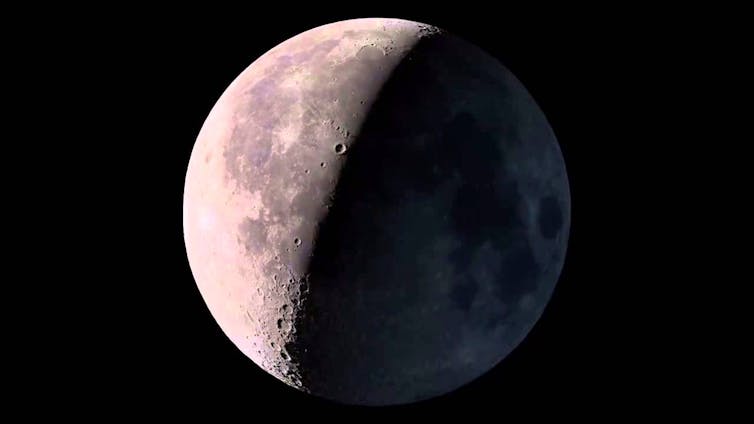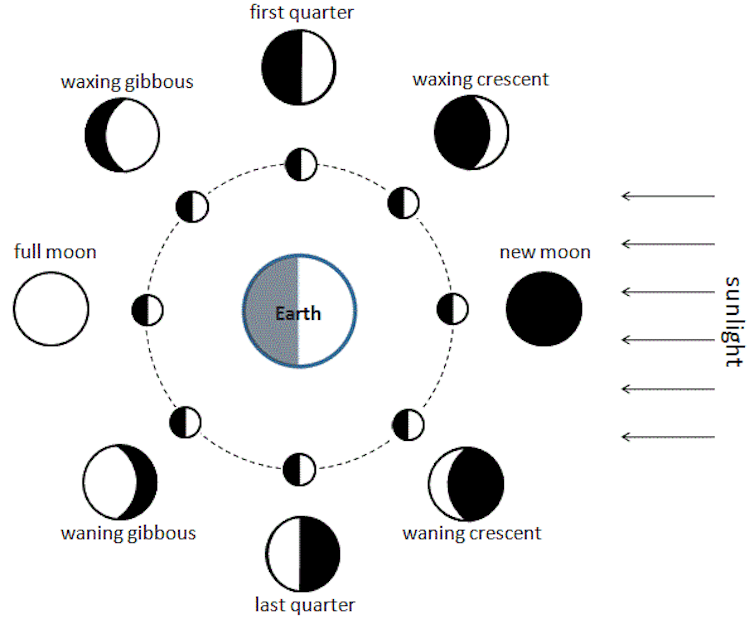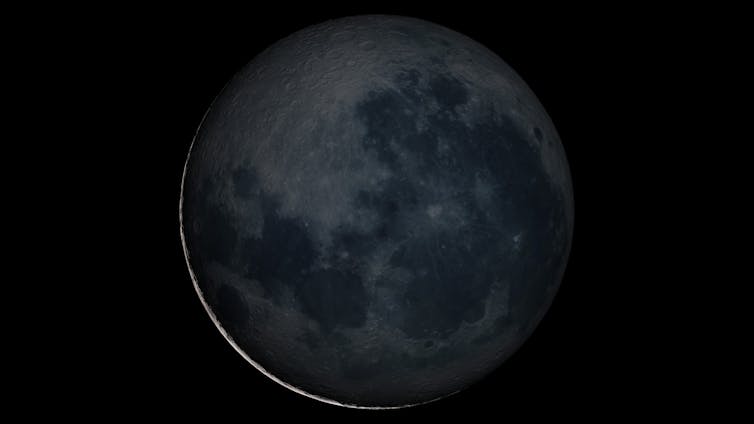Curious Kids: Why can I sometimes see the Moon in the daytime?
- Written by Duane W. Hamacher, Senior Research Fellow, Monash University
This is an article from Curious Kids, a series for children. The Conversation is asking kids to send in questions they’d like an expert to answer. All questions are welcome – serious, weird or wacky!
Why can I sometimes see the Moon in the daytime? – Sebastian, age 4, Brisbane.
Thank you, Sebastian, for your great question.
The Moon can be seen at different times during the day and night - but when and where you see it depends on the phase of the Moon.
 Our beautiful Moon.
NASA
Our beautiful Moon.
NASA
If you watch the Moon over a month, you will notice it gradually changing shape, from a crescent to a full circle, then back to a crescent again. If you pay close attention, you will notice that its position in the sky also changes.
You’ve heard of sunrise and sunset, but did you know there’s also moonrise and moonset? Here are the moonrise and moonset times for Brisbane, where you live.
The time of moonrise and moonset and the shape of the Moon change throughout the month, depending on where the Moon is in space.
The Moon moves around the Earth every month. But while it’s doing that, it is also spinning like a toy top – we call that spinning bit “rotating on its axis”.
The time it takes the Moon to rotate on its axis is the same time it takes to complete one trip (or “orbit”) around the Earth. This is why we always see the same side of the Moon.
It also follows a similar path across the sky as the Sun. As it goes around the Earth, sunlight bounces off the Moon and toward us from different angles.
 A Moon phase diagram, as seen from the northern hemisphere. In the southern hemisphere, it appears upside down.
Wikimedia Commons.
A Moon phase diagram, as seen from the northern hemisphere. In the southern hemisphere, it appears upside down.
Wikimedia Commons.
When the Moon is close to the Sun in the sky, the Sun is too bright for us to see it. As it moves away from the Sun in the sky each day, we see it emerge as a thin crescent. This called the New Moon.
If you look closely, you can see the faint glow of the “dark” part of the Moon. This is sunshine that is bouncing off of the Earth’s atmosphere back onto the Moon. Some Aboriginal groups see this as the spirit of the Moon-man.
 Earthshine and the thin crescent of a New Moon.
NASA Earth Observatory
Earthshine and the thin crescent of a New Moon.
NASA Earth Observatory
Each day we see more of the Moon’s lit side as it gets bigger and bigger. When the moon rises at midday, the left half of it is lit up. We call this the First Quarter.
Each day, the Moon rises about 50 minutes later than it did the day before. When it’s a Full Moon, it rises at sunset.
When the Sun rises in the early morning, the Full Moon sets. This is the only phase when the Moon is in the sky all night.
The Moon starts to fade again. When it rises at midnight, only the right half of the Moon is lit up, which we call Last Quarter. It moves closer to the Sun each day, turning back to a crescent and fading away until it disappears. It stays “hidden” for three days before it emerges again as a New Moon.
Hawaiian people have a special name for every day of the lunar month. You can learn their song to help you remember!
YouTube.Read more: Curious Kids: what started the Big Bang?
Hello, curious kids! Have you got a question you’d like an expert to answer? Ask an adult to send your question to us. You can:
* Email your question to curiouskids@theconversation.edu.au * Tell us on Twitter by tagging @ConversationEDU with the hashtag #curiouskids, or * Tell us on Facebook
 CC BY-ND
Please tell us your name, age and which city you live in. You can send an audio recording of your question too, if you want. Send as many questions as you like! We won’t be able to answer every question but we will do our best.
CC BY-ND
Please tell us your name, age and which city you live in. You can send an audio recording of your question too, if you want. Send as many questions as you like! We won’t be able to answer every question but we will do our best.
Authors: Duane W. Hamacher, Senior Research Fellow, Monash University
Read more http://theconversation.com/curious-kids-why-can-i-sometimes-see-the-moon-in-the-daytime-83969



